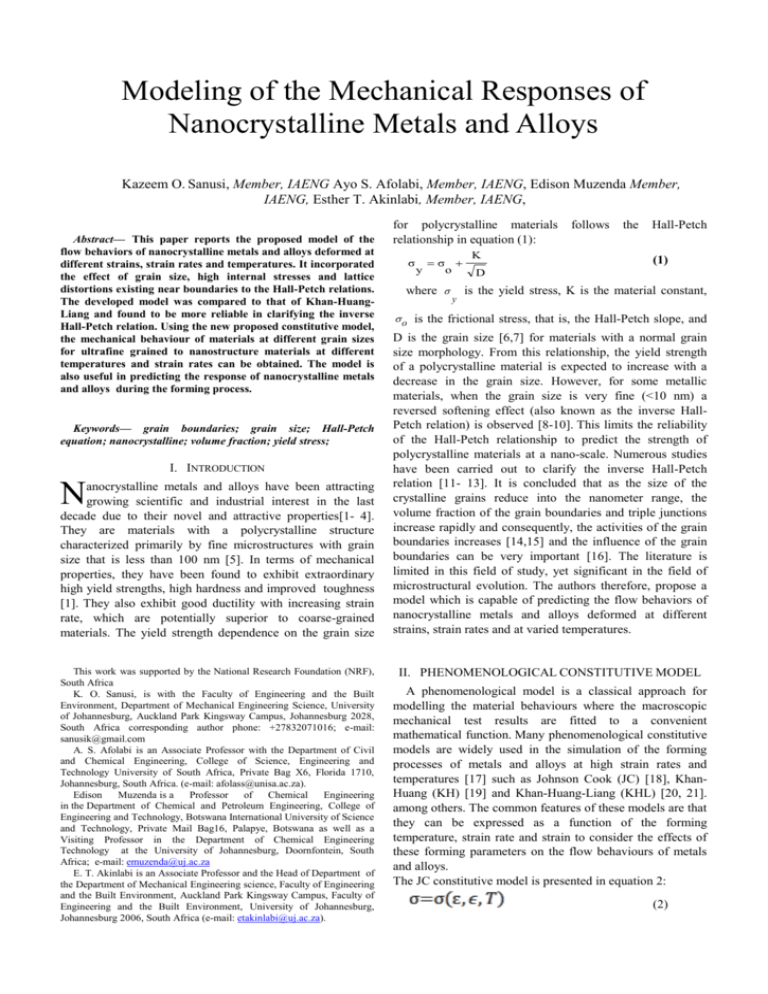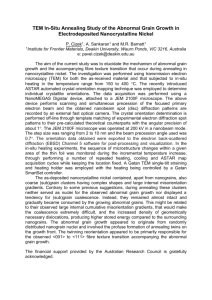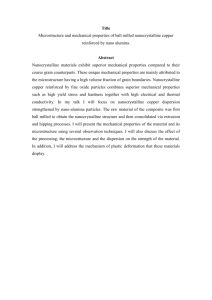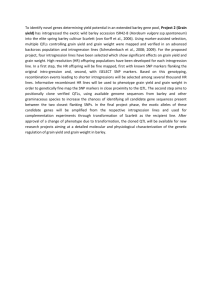View/Open - University of Johannesburg
advertisement

Modeling of the Mechanical Responses of Nanocrystalline Metals and Alloys Kazeem O. Sanusi, Member, IAENG Ayo S. Afolabi, Member, IAENG, Edison Muzenda Member, IAENG, Esther T. Akinlabi, Member, IAENG, Abstract— This paper reports the proposed model of the flow behaviors of nanocrystalline metals and alloys deformed at different strains, strain rates and temperatures. It incorporated the effect of grain size, high internal stresses and lattice distortions existing near boundaries to the Hall-Petch relations. The developed model was compared to that of Khan-HuangLiang and found to be more reliable in clarifying the inverse Hall-Petch relation. Using the new proposed constitutive model, the mechanical behaviour of materials at different grain sizes for ultrafine grained to nanostructure materials at different temperatures and strain rates can be obtained. The model is also useful in predicting the response of nanocrystalline metals and alloys during the forming process. Keywords— grain boundaries; grain size; Hall-Petch equation; nanocrystalline; volume fraction; yield stress; I. INTRODUCTION N anocrystalline metals and alloys have been attracting growing scientific and industrial interest in the last decade due to their novel and attractive properties[1- 4]. They are materials with a polycrystalline structure characterized primarily by fine microstructures with grain size that is less than 100 nm [5]. In terms of mechanical properties, they have been found to exhibit extraordinary high yield strengths, high hardness and improved toughness [1]. They also exhibit good ductility with increasing strain rate, which are potentially superior to coarse-grained materials. The yield strength dependence on the grain size This work was supported by the National Research Foundation (NRF), South Africa K. O. Sanusi, is with the Faculty of Engineering and the Built Environment, Department of Mechanical Engineering Science, University of Johannesburg, Auckland Park Kingsway Campus, Johannesburg 2028, South Africa corresponding author phone: +27832071016; e-mail: sanusik@gmail.com A. S. Afolabi is an Associate Professor with the Department of Civil and Chemical Engineering, College of Science, Engineering and Technology University of South Africa, Private Bag X6, Florida 1710, Johannesburg, South Africa. (e-mail: afolass@unisa.ac.za). Edison Muzenda is a Professor of Chemical Engineering in the Department of Chemical and Petroleum Engineering, College of Engineering and Technology, Botswana International University of Science and Technology, Private Mail Bag16, Palapye, Botswana as well as a Visiting Professor in the Department of Chemical Engineering Technology at the University of Johannesburg, Doornfontein, South Africa; e-mail: emuzenda@uj.ac.za E. T. Akinlabi is an Associate Professor and the Head of Department of the Department of Mechanical Engineering science, Faculty of Engineering and the Built Environment, Auckland Park Kingsway Campus, Faculty of Engineering and the Built Environment, University of Johannesburg, Johannesburg 2006, South Africa (e-mail: etakinlabi@uj.ac.za). for polycrystalline materials relationship in equation (1): σ y σ o where y K follows the Hall-Petch (1) D is the yield stress, K is the material constant, o is the frictional stress, that is, the Hall-Petch slope, and D is the grain size [6,7] for materials with a normal grain size morphology. From this relationship, the yield strength of a polycrystalline material is expected to increase with a decrease in the grain size. However, for some metallic materials, when the grain size is very fine (<10 nm) a reversed softening effect (also known as the inverse HallPetch relation) is observed [8-10]. This limits the reliability of the Hall-Petch relationship to predict the strength of polycrystalline materials at a nano-scale. Numerous studies have been carried out to clarify the inverse Hall-Petch relation [11- 13]. It is concluded that as the size of the crystalline grains reduce into the nanometer range, the volume fraction of the grain boundaries and triple junctions increase rapidly and consequently, the activities of the grain boundaries increases [14,15] and the influence of the grain boundaries can be very important [16]. The literature is limited in this field of study, yet significant in the field of microstructural evolution. The authors therefore, propose a model which is capable of predicting the flow behaviors of nanocrystalline metals and alloys deformed at different strains, strain rates and at varied temperatures. II. PHENOMENOLOGICAL CONSTITUTIVE MODEL A phenomenological model is a classical approach for modelling the material behaviours where the macroscopic mechanical test results are fitted to a convenient mathematical function. Many phenomenological constitutive models are widely used in the simulation of the forming processes of metals and alloys at high strain rates and temperatures [17] such as Johnson Cook (JC) [18], KhanHuang (KH) [19] and Khan-Huang-Liang (KHL) [20, 21]. among others. The common features of these models are that they can be expressed as a function of the forming temperature, strain rate and strain to consider the effects of these forming parameters on the flow behaviours of metals and alloys. The JC constitutive model is presented in equation 2: (2) . Where is flow stress, is strain is strain-rate and T is temperature, The Johnson-Cook (JC) constitutive model [18] is widely known as a forming temperature, strain and strain-rate dependent phenomenological flow stress model, and has been successfully applied to a variety of materials with different ranges of deformation temperature and strain-rate. This model assumes that materials are isotropic, to avoid the traditional concept of yield surface in constitutive equation. Introduce equation 3: . n (3) A B 1 C ln 1 T *m Where σ is the equivalent flow stress, ε is the equivalent plastic strain, A is the yield stress at reference temperature and reference strain-rate, B is the coefficient of strainhardening, n is the strain hardening exponent, C and m are the material constants which represent the coefficient of strain-rate hardening and thermal softening exponent, respectively. T* is the homologous temperature and expressed as, T Tr * T Tm Tr (4) T is the temperature, Tm is the melting temperature, Tr is the reference temperature Therefore, the model has enjoyed much success because of its simplicity and the availability of parameters for various materials [17 ]. A lot of modifications have been made to the Johnson Cook model. Zhang et al. [22] modified the original JC model by studying the effects of forming temperature on strain-hardening behaviour for IC10 alloy. The final modification of Johnson Cook model by Zhang et al is expressed as: . *m * n * A1T B (T ) 1 C ln (5) . * * Where; , , T are same as the original Johnson Cook model. In equation 5, B (T*) is a function of T* and can be determined as *m *m br 1 T 1 0.2 r 1 T * B (T ) n 1 P T * P T *P3 br 1 2 (6) Where; m1,P1 P2 and P3 are material constants, σbr is broken stress at room temperature and reference strain-rate, εbr is the broken strain at room temperature and reference strain-rate. The variation of the yield stress is asynchronous with the variation of the hardening component when temperature is changed. Lin et al [23] also proposed a model by modifying the JC model. They considered the yield and strain hardening portions of the original JC model and the coupling effects of the temperature and strain rate on the flow behaviors for the alloy steel. The Lin et al model is presented in equation 7: . . 2 * * A B B 1 C ln EXP ( ln ) T T 1 2 r 1 1 2 (7) Where; A1,B1 ,B2 ,C1,λ1, λ2 are the material constants, the . , , * T , Tr are identical to those of the meanings of original JC model. Hou and Wang [24] also modified JC models shown in equations 8 and 9: 1 C log10 * e1 T Tr . 0 B n (8) . * . n * 0 1 C2 ln B 1 C2 ln e 1 T Tr (9) Where; σ0 is the initial yield stress, B, C, C1; C2; λ1 and λ2 are the material constants. This equation could study the plastic response of the body-centered cubic (BCC) [25] and face centered cubic (FCC) [26] metals, but are not suitable to study the plastic response of the Hexagonal close packed (HCP) Magnesium alloys. So, Hou and Wang [24] proposed another modified JC constitutive model, as shown in Equation.10, to study the plastic response of the hot-extruded Mg-10Gd-2Y-0.5Zr alloy over a wide range of temperatures. T . T e m n * A B 1 C log10 1 T ee r Tm (10) Where the meaning of A, B,ε, n, C,T,Tm~ 610oC for the Mg-10Gd-2Y-0.5Zr alloy and Tr are the same as the original JC model , and λ is the material constant. The model shows a good agreement between the experimental data and the modified JC model correlations for the hot extruded Mg10Gd-2Y-0.5Zr alloy to predict the plastic response of the hot-extruded Mg–10Gd–2Y–0.5Zr alloy under both quasistatic and a wide range of temperatures even though the current temperatures were lower than the reference temperature. A constitutive model to predict the work hardening behaviour at large strain rates range for 1100 Aluminum on the approximation of isotropic hardening during large deformation was proposed by Khan and Huang in the 1990s [15,19]. They incorporated the Hall-Petch relation into the KH model to introduce the yield-stress dependence on the grain size and the KHL constitutive model was modified to include grain size dependence, work hardening, rate sensitivity and temperature effect to present the behaviour of fully compacted nanocrystalline iron. The material behaviour of iron with grain size in nm was described by generalized Hookes law before yielding, while the KHL model, modified by grain size effect, is used to reflect the stress/strain behaviour after yielding as per Equation 5 ao . ni . C m . k0 ln no TM T 1 B 1 p ( ) . D ln Do TM Tr * (11) Where; B , no, ni, C , m are the material constants, T is the temperature, Tm is the melting temperature, Tr is the p D reference temperature, o is the plastic deformation rate (is . . taken to be 106 s-1 ) is current strain and * =1s-1 is the reference strain rate. Khan et al.21 showed that the first term from equation 11 can be used for all grain size. The remaining of the equation retains its original form and relates the strain hardening to the strain, strain rate, and temperature [27, 28]. III. THE PROPOSED CONSTITUTIVE MODEL High Resolution Transmission Electron Microscopy (HRTEM) studies have shown that the local atomic structure of grain boundaries in nanostructure materials is similar to that in coarse grained metals, except that high internal stresses and lattice distortions exist near boundaries nanostructured materials [11, 29, 30]. Stress-type threshold behaviour for grain boundary deformation was considered in past works [8,31], They considered a constant value for the yield strength of the grain boundary as k*. The general equation for yielding can be written as per equations 12 and 13. * ( gb ) k , (12) k * f gb g f g in f gb , Where is the flow stress, gb (13) is the grain boundary stress, in is the internal stress along grain boundary, fgb is the volume fraction of the grain boundary, fg is the volume fraction of the crystalline part, g stress at the grain. In order to incorporate the volume fraction into yield stress, we substitute equation 14 f g (1 f gb ) into equation 13 and obtain * g ( k g ) f gb in f gb (k * g ) f gb K D (15) Equation 1 can now be rewritten as y ao ko D in f gb (16) Where ao is the frictional stress and ko is the material constant obtained from the experiment. The formula shows f that the grains are in nano- size and gb is noticeable.16 f The gb can be calculated from f gb 1 (1 w 3 ) D , boundaries, g is the shear strain within the grains but adjacent to grain boundaries, (16) and it can be calculated using equation 19: 2 g , (19) D Where δ represents the distance of mismatch or distortion in grains, but in the vicinity of grain boundaries that is equal to half of the inter-planar distance or half of the grain boundaries. In this work, Khan-Huang-Liang (KHL) model was modified by incorporating the effect of grain boundaries and the volume fraction of grain boundaries for nanocrystalline metals and alloys (21). It is assumed that when grains are in nano size and the volume fraction is noticeable, it is not the size of crystalline grain, the grain boundary condition also contributes to the yield stress and the lattice distortion along the grain boundaries can cause internal stresses. The constitutive equation used in formulation of the model is Johnson Cook model (18) and Khan-Huang-Liang model (19, 20). The models are coupled with the new model for inverse Hall-Petch equation that is observed for some materials, when the grain size is significantly below the micrometer range and where internal stresses along grain boundaries are assumed to strongly change, the yield strength of the nanocrystalline materials were taken into account. This phenomenological constitutive model is proposed to simulate the unique features of these materials and is presented in equation 20: . ni . C m k0 ln . no TM T ao in f gb 1 B 1 ( ) p . T T ln D D o * M r (20) (14) For coarse grain materials, the third item is very small and can be ignored, so that the first two terms of equation 15 is compared with Hall-Petch equation [32]. g o, Where w is the width of grain boundary. in can be calculated from 2G g . in G g . g D , (18) Where Gg is shear modules of grain next to grain (17) The parameters a 0 and k 0 are determined from the intercept and slope of the yield stress and grain size relation respectively. Using this proposed constitutive model, the mechanical responses of materials at different grain sizes for coarse grain, ultrafine grained to nanostructure materials at different temperatures and strain rates can be obtained. The newly developed model has been employed to make some interesting and useful predictions about the effect of grain structure, the strain rate and the temperature used in the experiment. The results are compared to those predicted using Khan-Huang-Liang model. The numerical simulations results were conducted and the constant used for simulation are tabulated in Table 1 where nanocrystalline copper was used as a bench mark. Table 1: The materials constant for nanocrystalline copper a0 169.7 k0 3537. B 3642.5 0.516 n 0 n1 C f gb -0.81 in 1700 Dop 106 m 1.53 the grain size is around 50 nm. At the lower temperatures 325-296 K and stabilized around 30nm for the Khan-HuangLiang model, and for the proposed model it shows that the yield strength of the nanocrystalline material was reduced due to the internal stress along the grain boundaries and the effects of grain volume fraction along the grain boundary. At high temperatures 573-425 K the yield strength of the nanocrystalline materials was low. 0.02 .0.711 IV. NUMERICAL SIMULATION RESULTS AND DISCUSSION The comparison of the yield strength and various grain sizes by Khan-Huang-Liang model and the proposed model are plotted. Figures 1 and 2 show the results of the yield stress vs grain size at various temperatures using KhanHuang-Liang model and the new proposed model at a strain rate of 10-2s-1. Figure 1: The stress profiles generated by the KhanHuang- Liang simulated at different temperatures with έ = 10-2s-1 Figure 2: The stress profiles generated by the proposed model simulated at different temperatures with έ =10-2s-1, f σin=1700 Mpa , gb = 0.711 The yield stress of the nanocrystalline materials drop sharply at high temperatures 425-400 K and stabilized when Figure 3: The stress profiles generated by the KhanHuang- Liang simulated at different temperatures with έ = 10-4s-1 Figure 4: The stress profiles generated by the proposed model simulated at different temperatures with έ = 10-4sf 1 ,σin=1700 Mpa , gb = 0.711 At the strain rate of 10-4s-1. The yield stress vs the grain sizes take the same pattern as when they are simulated at έ = 10-2s-1 see fig.3 and fig.4 and for the proposed model when simulated at lower temperatures (296-223K) the yield strength of the materials improve at various grain size. The yield strength was stabilizes when the grain size is around 50-60nm at the lower temperatures. This model is a useful tool for predicting the flow behavior of nanocrystalline materials when the grain sizes are less than 10 nanometer. This model can also be used to understand some aspects of the Hall-Petch phenomenon which is still unclear in the study of nanocrystalline metals and alloys. ACKNOWLEDGMENT Figure 5: The stress profiles generated by the KhanHuang- Liang that are simulated at temperatures with έ = 104 -1 s at Tc= 400K Figure 6: The stress profiles generated by the proposed model that are simulated at different temperatures with έ = f 2470s-1, Tc= 400K ,σin=1700 Mpa , gb = 0.711 -1 At high strain rate of 2470s increase in yield strength is observed as the grain size is decreased at a temperature of 400K. Comparing the result with the proposed model it shows that the yield strength of the nanocrystalline material was reduced due to the internal stress along the grain boundaries and the effects of grain volume fraction along the grain boundary. From the proposed model, one can conclude that the stress along the grain boundaries can affect the yield strength of nanocrystalline materials especially when the grain size is below 50 nm and leads to Inverse Hall-Petch effect. The developed model gives correlations with the experimental response of copper with grain size in nm. This can enhance understanding of the mechanical properties of other nanocrystalline materials. V. CONCLUSION A proposed model was used to explain the inverse HallPetch relation in nanocrystalline materials. The model showed that the internal stress along grain boundaries and volume fraction affected the yield strength of nanocrystalline materials. The model also predicts the response of nanocrystalline metals at different temperatures and strain rates especially at relatively high-strain-rate and different temperature conditions. From the results, it can be deduced that not only the size of crystalline grain, but also the boundary conditions contribute to the stress of the yields. The authors would like to acknowledge Prof. Daniel Makinde of the Faculty of Engineering, Cape Peninsula University of Technology, Bellville Campus, Cape Town, South Africa and Dr A. S. Mohammadabadi of Engineering Department, Sharif University of Technology, Tehran, Iran for useful suggestions on this work. REFERENCES [1] M.A.Meyer, A. Mishra, and D.J. Benson, "Mechanical properties of nanocrystalline materials," progress in Materials Science, vol. 51, pp. 427-556, 2006. [2] M. Furukuwa, Z.Horita, M. Nemoto, and T.G. Langdon, Journal of Materials Science, vol. 36, pp. 2835-3843, 2001. [3] H. Gleiter, "Nanocrystalline Materials," Progress in Materials Science, vol. 33, pp. 223-315, 1989. [4] R.Z Valiev, "Paradoxes of Severe Plastic Deformation," Advanced Engineering Materials, vol. 5, no. 5, pp. 296-300, 2003. [5] R. Song, D. Ponge, D Raabe, J.G.Speer, and D.K.Matlock, "Overview of processing, microstructure and mechanical properties of ultrafine grained bcc steels," Microstructure physics and Metal Forming. [6] E.O.Hall, "The deformation and ageing of mild steel III Discussion of results," Proceedings of the Physical society London , vol. 64, pp. 747-753, 1951. [7] N.J.Petch, "The cleavage strength of polycrystals.," Journal of Iron and Steel Institute, vol. 174, pp. 25-28, 1953. [8] E.V.Kozlov et al., "subgrains structure and internal stress fields in UFG materials : Problem of Hall-Petch relation," Journal of Materials Science and Engineering A, vol. 387-389, pp. 789-794, 2004. [9] F. Ebrahimi, G.R. Bourne, M.S. Kelly, and T.E.Matthews, "Mechanical Properties of Nanocrystalline Nickel Produced by Electrodeposition," Nanostructured Materials, vol. 11, pp. 343–350, 1999. [10] C.A. Schuh, T.G. Nieh, and T.Yamasaki, "Hall-Petch Breakdown Manifested in Abrasive Wear Resistance of Nanocrystalline Nickel," Scripta Mater, vol. 46, pp. 735–740, 2002. [11] T.G.Nieha and J.G.Wang, "Hall Petch relationship in nanocrystalline Ni and Be-B allys," Intermetallics, vol. 13, pp. 377-385, 2005. [12] M.Yu. Gutkin A.A. Fedorov and I.A. Ovid'ko, "Triple Junction Diffusion and Plastic Flow in Fine-grained Materials," Scripta Mater, vol. 47, pp. 51–55, 2002. [13] R.A. Masumura, P.M. Hazzledine, and C.S. Pande, "Yield Stress of Fine Grained Materials, ," Acta Mater, vol. 46, pp. 4527–4534, 1998. [14] A.A.Fedorov and I.A.Ovid’ko M.Yu Gutkin, "Triple junction diffusion and plastic flow in fine grained materials," Scripta Materials, vol. 47, pp. 51-55, 2002. [15] R.A.Masumura., P.M.Hazzledine, and C.S.Pande, "yield stress of fine grained materials," Acta Materials, vol. 46 , pp. 4527-4534, 1998. [16] A. S. Mohammadabadi and K. Dehghani, "A New Model for Inverse Hall-Petch Relation of Nanocrystalline Materials," Journal of Materials Engineering and Performance, vol. 17, no. 5, p. 662, october 2008. [17] Y.C. Lin and Xian-Min.Chen, "A critical review of experiment results and consitutive descrptions for metals and alloys in hot working," Journal of Materials and Design, vol. 32, pp. 1733-1759, 2011. [18] GR. Johnson and W.H.Cook, "A consititutive model and data for metals subjected to large strains, high strain rates and high temperatures," in Proceeding of the &th international Symposium on Ballistic, Den Haag The Netherlands, 1983, pp. 541-543. [19] A.S.Khan and S. Huang, "Experimental and theoretical study of mechanical behavior of 1100 aluminum in the strain rate range 10-5 10," International Journal of Plasticity, vol. 8, pp. 397-424, 1992. [20] A.S.Khan, H.Y.Zhang, and L Takacs, "Mechanical response and modelling of fully compacted nanocrystalline iron and copper," International Journal of Plasticity, vol. 16, pp. 2233-2248, 2000. [21] A.S.Khan, Y.S. Suh, X.Chen, L.Takacs, and H. Zhang, "Mechanical response and modelling of fully compacted nanocrystalline iron and copper," International Journal of Plasticity, vol. 22, p. 195, 2006. [22] H.J.Zhang, W.D.Wen, and H.T.Cui, "Behaviors of IC10 alloy over a wide range of strain rates and temperatures: experiments and modeling steel," Materials Science and Engineering A, vol. 504, pp. 99-103, 2009. [23] X.M.Chen Y.C. Lin and G Liu, "A modified Johnson–Cook model for tensile behavior of typical high-strength alloy steel," Mater Sci Eng A , vol. 527, pp. 6980–6986, 2010. [24] Q.Y.Hou and J.T. Wang, "A modified Johnson–Cook constitutive model for Mg–Gd–Y alloy extended to a wide range of temperatures.," Computatinal Materials Science, vol. 50, pp. 147152, 2010. [25] M.A.Meyers, Y.J.Chen, F.D.S.Marouis, and D.S.Kim, "High-strain, high-strain-rate behavior of tantalum.," Metall Mater Trans A, vol. 26, pp. 2493-2501, 1995. [26] Y.Wang, Y.X.Zhou, and Y.M. Xia, "A constitutive description of tensile behavior for brass over a wide range of strain rates.," Materials Science Eng A, vol. 372, pp. 186-190, 2004. [27] R.Liang and A.SKhan, "A critiacal review of experimental results and Constitutive models for BBC and FCC Metals over a wide range of starin rates and temperatures," International Journal of Plasticity, pp. 963-980, 1999. [28] H.S.Kim, Y. Estrin, and M.B.Bush, "Plastic deformation behaviour of fine grained materials," Acta Mater, vol. 48, pp. 493-504, 2000. [29] A.V.Sergueeva, V.V., Stolyarov, R.Z.Valiev, and A.K. Mukherjee, "Advance mechanical properties of pure titanium with ultrafine grained structure," Scripta Mater, vol. 45, pp. 747-752 , 2001. [30] N.Krasilnikov, W.Lojkowski, Z.Pakiela, and R.Z.Valiev, "Tensile strength and ductility of ultra fine grained nickel processed by Severe Plastic Deformation," journal of Materials Science and Engineering A, , pp. 330-337, 2005. [31] D.V.Bachurin, A.A.Nazarov, O.A.Shenderova, and D.W.Brenner, ", Diffusion- accommodated rigid body translation along grain boundaries in nanostructured materials," Journal of Materials Science and Engineering A, vol. 359, pp. 247-252, 2003. [32] Gou Xingming, Xiang Qing, "The scale effect on the yield strength of nanocrystalline materials," International Journal of Solids structures, vol. 42, pp. 1025-1030, 2006. [33] R.Birringer, Physical Metallurigal Materials Science, vol. 33, pp. 2685-2697, 1989. [34] H.Gleiter, "Materials with ultrafine microstructure: retrospectives and perspectives," Nanostructured materials , vol. 1, pp. 1-19, 1992.







